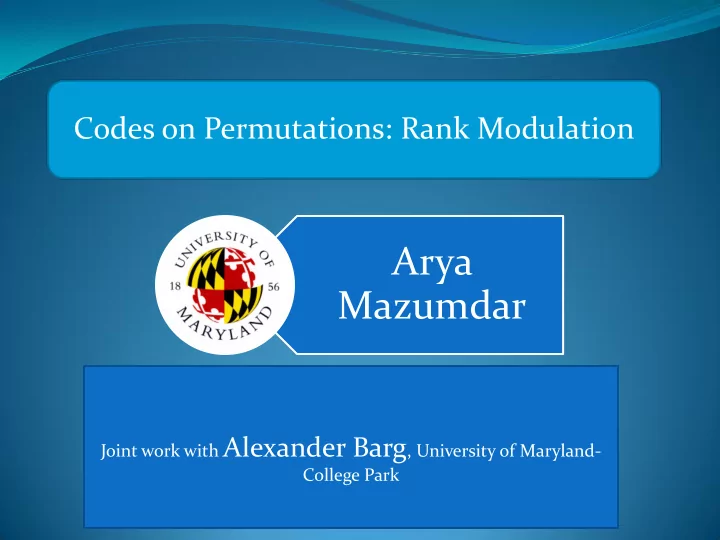

Codes on Permutations: Rank Modulation Arya Mazumdar Joint work with Alexander Barg , University of Maryland- College Park
Flash memory • Array of Floating Gate Memory Cells. • In abundant use for short-term storage and limited number of writes. • Can they be used as caches? • What is the best model for the errors in Flash memory? • How to increase the longevity of the flash devices? A USB Flash Drive. The • What will be the architecture of a high- chip on the left is the flash performance error-resilient Flash controller? memory. The controller is on the right (Wikipedia).
Reliability of data in Flash memory and rank modulation scheme Drift of charge from cells: Reliability of data stored. q q-1 . . . . . . 3 2 1 1 2 3 4 . . n Information is written in blocks of n cells with q charge levels in each cells.
Memory Cells q q-1 . . . . . . 3 2 1 1 2 3 4 . . n • Conventional q-ary codes can be used for protection of data. • The error process is non-conventional!
Error caused by drift of charge q q-1 . . . . . . 3 2 1 1 2 3 4 . . n • Due to charge leakage, after some time (aging of device) all cells will contain erroneous values. • Moreover the rate of leakage in different cells may vary. • Error correction schemes designed for q-ary writing will FAIL.
Storing data in Flash memory 1 2 3 4 5 6 7 4 6 7 1 5 3 2 • Rank Modulation Scheme (ISIT’08 Jiang/Schwartz/ Bruck). • Store information as the relative values of the charge levels. • σ = (4, 7, 6, 1, 5, 2, 3) • Levels can take continuous values.
Storing data in Flash memory 1 2 3 4 5 6 7 1 5 3 4 6 7 2
Storing data in Flash memory 1 2 3 4 5 6 7 4 6 7 2 5 3 1
Codes in permutations • S n = Group of permutations on n symbols • Vector representation: = ( (1), (2), … (n),) • Identity: (1, 2, 3, … ,n) • Multiplication: Composition (1, 3, 2, 4)(2, 4, 1, 3)=(2, 1, 4, 3) • Inverse: (3, 4, 2, 1)(4, 3, 1, 2) = (1, 2, 3, 4) • Transposition: (1,3, 5, 4, 6, 2) (1, 3, 5, 2, 6, 4)
Codes in permutations
Codes in permutations with Kendall metric
Rank modulation codes
Coding for the Kendall distance
Coding for the Kendall distance
Bounds on the size of codes
Capacity of rank modulation Scheme
To prove: basic arguments
To prove: basics of permutation 2 1 6 4 3 7 5 9 8 x σ 0 1 0 1 2 0 2 0 1
Direct attempt to find the volume of the sphere
Direct attempt to find the volume of the sphere
Direct attempt to find the volume of the sphere
Isometric embeddings
Isometric embeddings
Codes that correct t-errors
Existence of good codes: proof idea
Existence of good codes: proof idea
Existence of good codes: main tool
Existence of good codes: final step
Explicit constructions Permutation Polynomials: Polynomials that give bijective maps from a finite Construction from good codes of the field to itself. Hamming space: We find a distance Main Idea: Evaluations of permutation preserving Gray Map (and its polynomials of bounded degree forms a variations) for the space of inversion subset of Reed-Solomon code. vectors and the Hamming space of Problem 1: Identifying permutation comparable size. polynomials calls for extensive search. Consider special classes, such as, Remember we seek an additive error Linearized polynomials, Dickson correcting code in the space of polynomials, monomials. inversion vectors. Problem 2: Connecting Kendall Distance with Hamming distance is We obtain family of ‘good’ codes, difficult. We use certain accumulator- efficiently encodable and decodable , that corrects up to O(n 1+ ε ) number of type transformation that does the job for small distances. errors, for 0≤ε≤ 1.
To summarize:
Recommend
More recommend